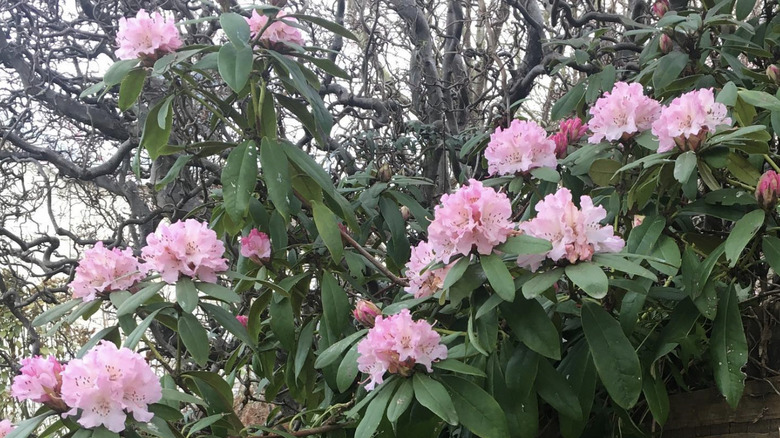A cold, harsh winter can transform our once-vibrant lawns into patches of brown grass and bare branches. As a result, a quick glance out of the window can look quite dismal. When you add the days getting shorter and the temperatures getting chillier, you might think that you’re doomed to seasonal drabness. However, a certain variety of rhododendron can bring an unexpected burst of color during the cold winter and liven up your icy yard. While most rhododendrons display vibrant blooms in spring, the Christmas Cheer rhododendron can defy the winter dormancy and offer pink blooms in January. It may even begin to bloom in late December. That certainly changes the winter view from your window.
Another perk to these plants is that it’s not only the blooms of the rhododendrons that provide color to a dark winter day. Their evergreen foliage, which is usually medium green, similar to emerald and olive, can also provide a welcome splash of life against the stark winter backdrop. This color adds depth and texture to your lawn and makes it look a little less barren.
How to plant Christmas Cheer rhododendrons

Two of the best ways to care for your rhododendron bushes are to choose the right plant and the right soil. So before you buy the first rhododendron you stumble upon, remember that not all varieties of rhododendron are made to thrive in winter weather. Christmas Cheer rhododendrons, however, are exceptionally cold-hardy and can tolerate temperatures as low as minus 10 degrees Fahrenheit. Others can die in the harsh winter frosts.
When planting these winter bloomers, timing is key. Plant your rhododendrons in spring or early fall, so they have enough time to establish roots before winter. Choose a location with well-draining soil and partial shade. Then apply a generous layer of acidic mulch around the base of your rhododendron to help retain moisture and maintain soil temperature.
However, it is also important to remember that even though Christmas Cheer rhododendrons can survive a harsh winter climate, it doesn’t mean that you shouldn’t try to protect them from wind and storms. Plant these winter bloomers in sheltered spots that are protected from harsh winds and frost. South-facing walls or sheltered corners are ideal to help your rhododendron thrive.
Christmas Cheer rhododendrons are low maintenance

waiflowersnz23/Instagram
Another added benefit of Christmas Cheer rhododendrons is that rhododendrons in general are surprisingly low maintenance. They thrive in acidic soil, which you can easily create by incorporating organic matter like peat moss or composted leaves. Once established, the Christmas Cheer variety requires moderate watering. With proper care, they can grow to 4-6 feet tall.
For added color in your yard, combine the Christmas Cheer rhododendrons with other plant varieties. If you want to keep your yard colorful in the spring, plant several different types of rhododendrons since most of them bloom in the spring and summer. You might be able to keep your yard vibrant with rhododendron blooms all year long.
For more winter color, you could plant hellebores, which have flowers that range from delicate white to pink and bloom from November through spring. Winterberry is a shrub that blooms into December and has red berries that cling to its bare branches, which makes for a beautiful contrast against a snowy backdrop. Witch hazel is another winter shrub; it can bloom from October through March and offers a pop of color with yellow flowers. With a little planning and the right plant picks, you can create a vibrant view in your yard even during the cold days of winter.



